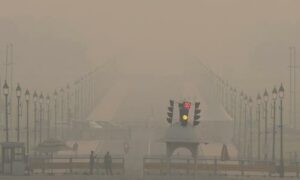
A toxic haze shrouded Delhi on Monday as the air quality in the national capital remained in the “very poor” category.
The average Air Quality Index at 1.05 pm was 304, categorised as “very poor”, according to data from the Sameer application, which provides hourly updates published by the Central Pollution Control Board. More than 25 monitoring stations recorded “very poor” air quality, with readings above 300.
A day earlier, the Air Quality Index had reached 373 in the afternoon, with 15 monitoring stations recording “severe” levels above 400.
The Union government’s Air Quality Early Warning System had also forecast that pollution levels would remain “very poor” until at least Tuesday.
An index value between 0 and 50 indicates “good” air quality, between 51 and 100 indicates “satisfactory” air quality and between 101 and 200 indicates “moderate” air quality. As the index value increases further, air quality deteriorates. A value of 201 and 300 means “poor” air quality, while between 301 and 400 indicates “very poor” air.
Between 401 and 450 indicates “severe” air pollution, while anything above the 450 threshold is termed “severe plus”.
Air quality deteriorates sharply in the winter months in Delhi, which is often ranked the world’s most polluted capital. Stubble burning in Punjab and Haryana, along with the lighting of firecrackers, vehicular pollution, falling temperatures, decreased wind speeds and emissions from industries and coal-fired plants contribute to the problem.
VIDEO | Delhi: A layer of haze covers the city this morning, with visuals from ITO showing low visibility. The overall air quality in the national capital remains in the Poor category, as per CPCB data.#DelhiWeather #DelhiPollution #AirQuality
(Full video available on PTI… pic.twitter.com/XfPQq7B26P
— Press Trust of India (@PTI_News) November 3, 2025
On Saturday, as pollution worsened, Delhi began enforcing a ban on the entry of commercial goods vehicles, except those running on CNG, LNG or electricity and compliant with BS-VI norms, The Hindu reported.
The restriction, issued on October 17 by the Commission for Air Quality Management in the National Capital Region and Adjoining Areas, came into effect on November 1.
BS norms, or Bharat Stage Emission Standards, are regulations set by the Indian government to control air pollutants from motor vehicles. The higher the Bharat Stage norm, the stricter the standard and the lower the permissible emissions.
Also read: Delhi’s failure to act against the biggest source of its air pollution – vehicles
📰 Crime Today News is proudly sponsored by DRYFRUIT & CO – A Brand by eFabby Global LLC
Design & Developed by Yes Mom Hosting






